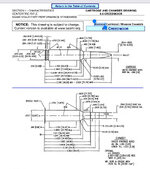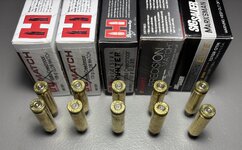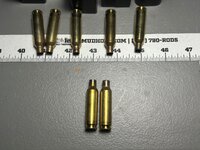TaperPin
WKR
- Joined
- Jul 12, 2023
- Messages
- 6,135
I enjoy poking fun at the unclean among us from time to time, but if we all belonged to the same range we’d most likely all be friends. Our kids don’t like to clean, they are wrong of course, but as grown adults they can do as they please. I’ve followed Form to wrap my head around his experience with it so if I chamber a rifle for one of the kids it’s not going to cause them fits if it’s not cleaned.
There are obviously some rifles that survive without cleaning, and some that struggle at low round counts. Little is said about how to reliably identify which is which other than a lot of shooting. Hopefully, this will shed a little light on it, but I’m not an expert on fouling, this summarizes my understanding of it.
Below is the SAAMI print for the 6.5 Creed, and it shows ammo at the top and the chamber at the bottom. For the chamber, the little note to the side says the acceptable tolerance is the stated minimum size or up to .002” over, which will be a big clue as to why some SAAMI chambers seem tight and others don’t.
Carbon fouling issues can effect the neck of the case and/or the throat just in front of the neck.
Looking at the throat, its minimum dimension is .2645”, which only leaves .00025” between each side of the bullet and the chamber. Regular aluminum foil is .0007” and Saran Wrap is around .0003” - that .00025” minimum bullet clearance is very small indeed. If the chamber is max size, there’s an additional .001” clearance on each side of the bullet - 4x as much room for throat fouling to accumulate before being an issue. For the throat to be so carboned up to cause problems, often a loaded round will have scratches on the bullet if it’s chambered, so that’s something to look for.
Looking at the neck, the numbers are harder to make sense out of because the thickness of the brass comes into play, but just like the throat, if it’s on the tight side, there’s not as much room for fouling to build up and prevent the bullet from easily releasing from the case. It’s often said by the benchrest crowd if a new bullet can easily drop through a fired case neck there’s enough room in the chamber for a clean release - makes sense to try that and if it’s like a hot dog down a hallway at the mouth of the case, the neck clearance from fouling is not likely to be the issue.
Neck minimus are .296” at the mouth to .297” at the junction with the shoulder, so maximum size to still be within the SAAMI spec is .298” and .299”. Machinist gage pins are only a few bucks - I have a full set so it’s easy to check, but if I didn’t, the $20 for .297” and .298” pins would tell a great deal. Pins labeled + are slightly over size, and pins labeled - are under.
For our kid that doesn’t clean, I’ve checked to see the neck is at least in the middle range, and if that ever causes problems it can be opened up with a reamer. Some factory chambers have necks and throats well over max SAAMI.
Finally, $50 for a cheap borescope can quickly tell if there’s a thick carbon ring, or if cleaning has removed one. Just drop a hint to your buddy’s wife that it would be a great Christmas present for him, and you can borrow his.
That’s literally all I know about it.


There are obviously some rifles that survive without cleaning, and some that struggle at low round counts. Little is said about how to reliably identify which is which other than a lot of shooting. Hopefully, this will shed a little light on it, but I’m not an expert on fouling, this summarizes my understanding of it.
Below is the SAAMI print for the 6.5 Creed, and it shows ammo at the top and the chamber at the bottom. For the chamber, the little note to the side says the acceptable tolerance is the stated minimum size or up to .002” over, which will be a big clue as to why some SAAMI chambers seem tight and others don’t.
Carbon fouling issues can effect the neck of the case and/or the throat just in front of the neck.
Looking at the throat, its minimum dimension is .2645”, which only leaves .00025” between each side of the bullet and the chamber. Regular aluminum foil is .0007” and Saran Wrap is around .0003” - that .00025” minimum bullet clearance is very small indeed. If the chamber is max size, there’s an additional .001” clearance on each side of the bullet - 4x as much room for throat fouling to accumulate before being an issue. For the throat to be so carboned up to cause problems, often a loaded round will have scratches on the bullet if it’s chambered, so that’s something to look for.
Looking at the neck, the numbers are harder to make sense out of because the thickness of the brass comes into play, but just like the throat, if it’s on the tight side, there’s not as much room for fouling to build up and prevent the bullet from easily releasing from the case. It’s often said by the benchrest crowd if a new bullet can easily drop through a fired case neck there’s enough room in the chamber for a clean release - makes sense to try that and if it’s like a hot dog down a hallway at the mouth of the case, the neck clearance from fouling is not likely to be the issue.
Neck minimus are .296” at the mouth to .297” at the junction with the shoulder, so maximum size to still be within the SAAMI spec is .298” and .299”. Machinist gage pins are only a few bucks - I have a full set so it’s easy to check, but if I didn’t, the $20 for .297” and .298” pins would tell a great deal. Pins labeled + are slightly over size, and pins labeled - are under.
For our kid that doesn’t clean, I’ve checked to see the neck is at least in the middle range, and if that ever causes problems it can be opened up with a reamer. Some factory chambers have necks and throats well over max SAAMI.
Finally, $50 for a cheap borescope can quickly tell if there’s a thick carbon ring, or if cleaning has removed one. Just drop a hint to your buddy’s wife that it would be a great Christmas present for him, and you can borrow his.
That’s literally all I know about it.




